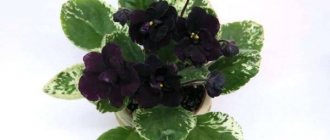Among the many varieties of Saintpaulias, there are a lot of blue ones , but Rustle Ox occupies a special place. The beautiful shade of the flowers, their shape and ruffles along the edges attract attention, and the dark leaves set it off favorably.
Saintpaulia is not capricious, but to get an ideal rosette and beautiful flowering,
you need to follow the rules . Some nuances in care help gardeners achieve maximum results. You will see a photo and description of the flower in the article.
Violets and Saintpaulias
Saintpaulia, popular among gardeners, actually has nothing to do with the flowers of the Violet family.
They were discovered by accident in the 90s of the 19th century by the military commandant of the Uzambara district of the German colony in East Africa. It was Baron Walter von Saintpaul. In his honor, the plant received its specific name - Saintpaulia. The seeds sent to Germany sprouted, and the plant was soon described by naturalist Hermann Wendland as Saintpaulia violet-flowered (or violet-flowered). There is indeed a resemblance between Saintpaulias and violets, but only externally. An African plant with flowers similar to violets began to spread in Europe. Without going into details of the classification, amateur flower growers very quickly began to call it “violet”.
Reviews
Pauline. “The variety is very prolific, produces a lot of children. I am very glad that I once bought it, the flowering makes me happy every time. Beautiful flowers of stunning size are a delight to the eye. Shaded by dark leaves, the flowers seem even more vibrant and beautiful.”
Many gardeners like the Violet Rustle of Waves.
Alexandra. “I really love blue and light blue Saintpaulias. Not long ago I bought myself a blooming beauty - LIK-Rustle of Waves. When I brought it home, I enjoyed its beauty for a long time; it bloomed long and tenderly. When the flowers fell, I planted its leaves and got a lot of babies. They grow quickly, and my beauty is already blooming again. The socket is a little large and very fragile, it stands alone, but it’s worth it.”
Description of varieties
“LE-Lilac Rain” is a variegated variety with large double flowers of a soft lilac color and fancy dark purple streaks. The diameter of the flowers can vary from 4.5 to 5.5 cm. The leaves are large, uniformly emerald in color with light beige wavy edges. The sockets are characterized by extraordinary compactness and accuracy. The variety is easy to care for.
“LE-Lilac Tenderness” is an unpretentious variety that produces large and lush lilac-white or white-pink star-shaped flowers. The fleshy, succulent leaves have a slightly pointed tip. The color of the leaves is uniform, emerald or dark green.
“Lilac Charm” is an elegant Saintpaulia with large fringed flowers of a pale lilac color and a thin rich purple edging. A characteristic feature is 3 purple markings located in the center of the flower. The leaves have a regular round shape and slightly wavy edges. The variety is very decorative, characterized by abundant and surprisingly long flowering.
“N-Lilac Smiley” is a beautifully flowering Saintpaulia with large, fringed, amethyst-colored flowers with a bright white edge. The rounded leaves are deep dark green on the outside and reddish on the inside. Peduncles form en masse in the center of a compact rosette.
“RS-Lilac Miracle” is a very spectacular Saintpaulia variety that produces large double flowers of a pale purple color and a lightened edge. The diameter of the flowers can reach 7 centimeters. The leaves are simple, round in shape and uniformly green in color. The diameter of the rosette is about 25 centimeters. The variety is considered very unpretentious, easy to care for and reproduce.
“Lilac Excitement” is an elegant Uzambara violet with very large fringed flowers. The two-color petals combine dark purple and pale purple shades, harmonizing well with the dark emerald foliage. The leaves on the inside are reddish in color.
“PT-Lilac Distance” is an original variety with large single or semi-double flowers. The petals are light amethyst in color with deep purple shading on the wavy edges. The plant forms a neat rosette of variegated leaves with a dark emerald core and a light beige uneven edge.
“Lilac Sand” is a variety of Uzambara violet that has an original and spectacular color. The peculiarity of the plant is its simple pale pink large flowers, dotted with a scattering of small dark purple splashes and framed by an edging of the same shade. The leaves have a classic oval shape and color ranging from pale green to a uniform dark emerald hue.
“Lilac Mist” is an Uzambara violet that forms a beautiful and compact rosette of emerald succulent leaves with jagged edges. During the flowering period, it forms multiple peduncles located in the center of the rosette. The color of the flowers varies from pale amethyst to purple. The ruffled petals have intricate wavy edges. The variety is considered demanding of care; if the rules are not followed, the plant stops blooming.
“Lilac watercolor” is a very spectacular variety, notable for its large, voluminous flowers of pale amethyst color with white spots shifted to the edge or to the center of the petals. The beautiful blurred transition from white to light purple creates a striking contrast against the dark green velvet leaves.
“AV-Purple Elephant” is a relatively young variety that forms a large number of buds during the flowering period. Very large double flowers are collected in thick, voluminous clusters. The color of the petals is a uniform and rich indigo color with an elegant white edging at the edges.
“Lilac Charm” is an unusually beautiful variety, valued by flower growers for its impressive decorative properties. The flowers of this Uzambara violet can be either double or semi-double. The highlight of the variety is the amazing color of the petals - tiny and numerous lilac-raspberry splashes on a delicate pearl pink background. It is noteworthy that closer to the edges of the petals the spray thickens, turning into a beautiful dark lilac edging.
“KO-Lilac Paradise” is an amazingly beautiful variety of Saintpaulias, distinguished by a proportional compact rosette. During the flowering period, a lush cap of flowers of a delicate amethyst color is formed in the center of the rosette. A light snow-white border is allowed on the petals. The leaves have regular rounded outlines, wavy edges and a slightly pointed tip.
Violet Crimean Spring (K. Morev)
Genus, family
The variety “Crimean Spring” by Konstantin Morev belongs to the Uzambara violets, belongs to the Gesneriev genus .
History of the variety
Konstantin Morev is a famous breeder whose varieties have bright, memorable colors . Many of them became favorites and settled firmly in the collections of lovers of Uzambara violets.
Konstantin Morev has been breeding since 1994; he is a talented student of the famous breeder Boris Mikhailovich Makuni.
The events of the Crimean Spring found a response outside the Crimean Peninsula; in 2015, in St. Petersburg, breeder from Moscow Konstantin Morev presented his new variety “Crimean Spring” .
Photo and description
Violet Moreva Crimean Spring has a very interesting color . The flowers are large, star-shaped, the petals are simple and semi-double, with a crimson-violet curly border. Crimson-violet stars bloom very light, and during flowering they gain brightness and color.
The corner areas of the flower's petals darken faster, and all the petals have a yellow-green outline , which intensifies towards the full dissolution of the flower, while strongly emphasizing the contrast with the bright crimson-violet flower.
Bright violet Crimean Spring.
The tissue of the petals is dense , which is another feature of this variety; it allows:
- Keep flowers fresh;
- And increases the duration of flowering.
But the density of the petals does not prevent the branch from blooming completely.
The rosette of the SM-Crimean Spring variety is standard, growing from 20 cm to 40 cm in diameter.
Attention! A very symmetrical rosette is formed, the color of the leaves is green or light green.
Features of cultivation
To ensure optimal conditions for the development of violets, you should provide it with proper lighting, protect it from drafts, and do not forget about irrigation and the introduction of nutrients. Saintpaulia will be able to bloom for nine and a half months a year, including winter. In summer, flowering is likely to be interrupted, since excessively high temperatures interfere with it. The soil mixture for “Whipped Cream” can be easily purchased at the store or you can make it yourself. Saintpaulia will like the combination of turf, coniferous soil, sand and leaf soil, taken in equal parts. Before use, the mixture will have to be disinfected: either kept in the freezer for a whole day, or heated in an oven heated to 200 degrees for an hour.
The soil for violets should be saturated with useful substances, loose and permeable to both air and moisture. You should not enrich it with rotted manure, as this will activate the growth of green mass instead of promoting flowering. To choose the most successful pot, you need to measure the diameter of the outlet - the capacity should be 3 times larger than the indicator. There must be drainage holes to ensure drainage of liquid after irrigation.
Lighting should be in moderation, since the violet will suffer both in the case of direct exposure to sunlight and when located in a darkened space. In the cold season, the flower feels great on the windowsills of windows facing south, but in the summer it will have to be moved to windows facing north. To create the diffused lighting that Saintpaulia likes, you can place fabric or white paper between the glass and the plant itself. The violet will need 10 to 12 hours of daylight, but during the flowering period it is a good idea to provide additional lighting. It is recommended to move the flower pot 90 degrees twice a week. This action will make it possible to achieve uniformity in the development of the leaf rosette.
In the summer, the optimal temperature is between 24 and 26 degrees, and in winter, “Whipped Cream” can be grown at 18 degrees. Air humidity should be at least 50%, but it is strictly not recommended to spray it to increase it, as this threatens the appearance of ugly brown spots.
When planting a plant in a pot, you must first create a drainage layer, the thickness of which is 2 centimeters. Next, a small amount of soil is poured on top, and the seedlings themselves are placed. The soil mixture is laid out in a circle on top, and everything is carefully slammed down.
Features of flowering, growth and reproduction
With regular feeding and compliance with the entire range of agricultural technology, the variety blooms all year round , with a short break of two or three months.
This variety blooms very luxuriantly.
Important! Saintpaulia is hypoallergenic. Violets have no odor, and their pollen is kept in closed “bags” and practically does not spill out. And if the leaves of the plant are eaten by animals, it will not cause poisoning.
Development at home
At home, the plant feels good , the main thing is to create the necessary conditions suitable for the plant.
How long does it take to grow an adult plant?
From the moment the cutting takes root and the baby grows to an adult plant, it takes about 9-10 months .
Flowering in hot and cool conditions
The variety tolerates temperature fluctuations well, but at the same time, like all Saintpaulias, it does not like too high a room temperature .
At a temperature of about 30 degrees, the plant dries out very tiny flower stalks.
And if the temperature is too low, its growth and development are inhibited, and there will be no flowering until the temperature returns to normal.
What do flower stalks look like?
The peduncles are strong, erect, and hold the blossoming flowers in a dense cap.
Is it possible to achieve cap flowering?
It is easy to achieve cap flowering from the variety. By following the recommendations on agricultural technology (plant care), “Crimean Spring” will give you a dense cap of flowers.
Bud lifespan
The bud opens slowly , while the flowers remain fresh for one to two months.
Well, almost black violet Dark Night of The Soul
Speaking of almost black varieties, it is impossible to ignore the Dark Night of The Soul variety.
A beautiful, even, symmetrical rosette, semi-miniature in size, which forms independently. The leaves are variegated, rounded, and quite large. A special feature of the variety are spoon-shaped leaves, the edges curl slightly upward. The color of the leaves is variegated, medium green with white.
The flowers are wine-black, double pansies with a coral-red underside. In bud, the half-opened flower is almost black, but as it opens it acquires a red, rather beet-like, hue.
Important! This variety is the only one bred by McDonald outside the Mac's series.
Reproduction of such Saintpaulias
To preserve the mother color of the plant, the usual method of propagation by cuttings is not suitable in the case of chimera violets.
The following methods allow you to maintain the desired color:
- Reproduction using peduncles. At their base there is a dormant bud, from which, when carefully cut and rooted, a new shoot grows. He will eventually become a new violet.
- The upper part of the plant, along with flowers and one row of leaves, is completely cut off and planted in the ground. To avoid excessive evaporation of moisture, before roots appear, it is covered with film or glass containers to create greenhouse conditions.
- Rooting by stepchildren. To do this, the topmost shoot is cut off. After some time, lateral layers appear at the site of the break. These cuttings can be plucked and planted in the ground.











